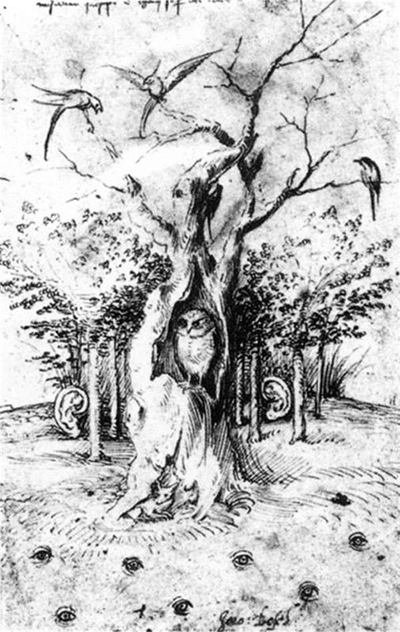The Wood has Ears, the Field Eyes is another Hieronymus Bosch recto verso, with drawings on both sides of the paper
Whilst those on the opposing side are attributed to members of Bosch's studio, The Hearing Forest and the Seeing Field is entirely Hieronymus's own. It is perhaps the shading of the tree and the eye catching owl that are the main elements to see in this piece, whilst ears are placed in the other trees that sit in the background.
This double sided artwork can now be found at the Staatliche Museen zu Berlin, in Germany. There are facial studies on the other side which bear no real connection to each other and are seemingly placed randomly and purposely each and every spare corner is used. As part of his studio's work, it is interesting to see their working processes, but the main interest will always be in The Wood has Ears, the Field Eyes on the other side.
Whilst Bosch's drawings are respected, he is not rated in the same class in this medium as the likes of Raphael, Michelangelo or da Vinci. His use of this medium along with multiple engravings does underline his wide ranging skills and ability to adapt to different challenges. Fellow Northern Renaissance member, Albrecht Durer, was also dominant in engravings and woodcuts.
Bosch places a quote at the top of the drawing which reads, once translated into English, as "... For poor is the mind that always uses the ideas of others and invents none of its own...". It is added to the Hieronymus Bosch quotes page, although it is a religious text that has been traced back to the 13th century and so were not his own words. There are also further texts on the artwork on the other side of the paper that discuss how the world will end at the end of the year 1000, and this theme fits Bosch's artistic style perfectly.
This drawing is considered amongst Bosch's most impressive and also most important. Two detailed studies have been made into this drawing alone, looking into some of the Christian symbolism that the owl in particular represents. There have been multiple intepretations over the years, with some considering it a self-portrait of the artist himself. Others have claimed its elements together produce the word 's-Hertogenbosch but this appears to most as unlikely.




